|
|
|
Sort Order |
|
|
|
Items / Page
|
|
|
|
|
|
|
| Srl | Item |
| 1 |
ID:
106612
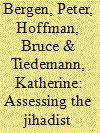

|
|
|
|
|
| Publication |
2011.
|
| Summary/Abstract |
Al Qaeda and allied groups continue to pose a threat to the United States. Although it is less severe than the catastrophic proportions of a 9/11-like attack, the threat today is more complex and more diverse than at any time over the past nine years. Al Qaeda or its allies continue to have the capacity to kill dozens, or even hundreds, of Americans in a single attack. A key shift in the past couple of years is the increasingly prominent role in planning and operations that U.S. citizens and residents have played in the leadership of Al Qaeda and aligned groups, and the higher numbers of Americans attaching themselves to these groups. Another development is the increasing diversification of the types of U.S.-based jihadist militants, and the groups with which those militants have affiliated. Indeed, these jihadists do not fit any particular ethnic, economic, educational, or social profile. Al Qaeda's ideological influence on other jihadist groups is on the rise in South Asia and has continued to extend into countries like Yemen and Somalia; Al Qaeda's top leaders are still at large, and American overreactions to even unsuccessful terrorist attacks arguably have played, however inadvertently, into the hands of the jihadists. Working against Al Qaeda and allied groups are the ramped-up campaign of drone attacks in Pakistan, increasingly negative Pakistani attitudes and actions against the militants based on their territory, which are mirrored by increasingly hostile attitudes toward Al Qaeda and allied groups in the Muslim world in general, and the fact that erstwhile militant allies have now also turned against Al Qaeda. This article is based on interviews with a wide range of senior U.S. counterterrorism officials at both the federal and local levels, and embracing the policy, intelligence, and law enforcement communities, supplemented by the authors' own research.
|
|
|
|
|
|
|
|
|
|
|
|
|
|
|
|
| 2 |
ID:
115491
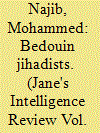

|
|
|
| 3 |
ID:
084627
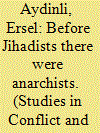

|
|
|
|
|
| Publication |
2008.
|
| Summary/Abstract |
With the wave of violent jihadist activities in recent years, the world's attention has shifted away from a traditional prioritizing of state forms of formal violence toward one focusing on an apparently "new" phenomenon of transnational violence. Yet transnational violence itself is not a new phenomenon; it in fact precedes international, state-centric violence. For reasons related to gaps or defects within the state system or to surges in the capacities of individuals and societies, transnational violence has periodically made attempts to regain its primary position. Prior to the violent jihadists, the last of these efforts was that of the late-nineteenth-century Anarchists. This article looks at the dynamics of the Anarchists's failure as part of a transnational violence continuum, using a framework based on their autonomy, representation, and influence. The results provide an historical example against which future studies about the current episode of transnational violence may be compared.
|
|
|
|
|
|
|
|
|
|
|
|
|
|
|
|
| 4 |
ID:
129602


|
|
|
| 5 |
ID:
116664
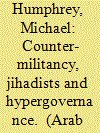

|
|
|
| 6 |
ID:
160127
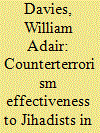

|
|
|
|
|
| Summary/Abstract |
A comparative analysis of Islamic extremism post-9/11 to 2015 and the effectiveness of the counterterrorism (CT) authorities to counter it in both Western Europe and the United States was conducted. Four measures of effectiveness revealed that 2010–2015 saw a gradual increase in jihadi attacks and in casualties emanating from these attacks, and more jihadists, foreign fighters, and material supporters. Additionally, 2013–2015 saw a 22 percent reduction both in Western Europe and the U.S. CT agencies' ability to counter Islamic extremism. We are losing the War on Terror and our citizens are less safe than they were six years ago. Further analysis revealed that singleton jihadists: (1) were much harder than group-based jihadists to uncover, (2) have been increasing since 2009, and (3) have generated over 70 percent of all jihadi violence. Finally, numerous similarities exist between Western Europe and the United States with respect to jihadism in their homelands and their respective CT effectiveness, indicating close cross-Atlantic CT collaboration since 9/11. This in-depth analysis provides essential threat/hazard information to security, law enforcement, intelligence, and policymaking personnel and the greater homeland security communities.
|
|
|
|
|
|
|
|
|
|
|
|
|
|
|
|
| 7 |
ID:
073052
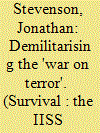

|
|
|
|
|
| Publication |
2006.
|
| Summary/Abstract |
The elimination of Afghanistan as al-Qaeda's physical base in 2001 hastened the dispersal of global jihadists into cities. In turn, the advent of Iraq as a field of jihad has prompted jihadists to refine and spread urban warfare techniques. If they choose to apply these techniques robustly to infiltrated cities elsewhere, the extraordinary need for special-operations forces - superseding the Western taboo on using a nation's military forces against its own citizens within its own territory - could arise. The US Department of Defense appears inclined to believe that the application of military power - albeit unconventional military power - will ultimately dictate victory. Such an attitude could lead to the downplaying of paramount non-military aspects of counter-terrorism, to the detriment of national and international security. If the US State Department were armed with a mandate to coordinate national counter-terrorism efforts, diplomatic, political, law-enforcement and intelligence efforts against terrorism would gain momentum and coherence.
|
|
|
|
|
|
|
|
|
|
|
|
|
|
|
|
| 8 |
ID:
152872
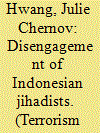

|
|
|
|
|
| Summary/Abstract |
While much research has been conducted on the radicalization of Muslim militants from Jemaah Islamiyah, its spinoffs, and splinter factions; the historical roots of Indonesian radical movements; and their ideological underpinnings, far less analysis has centered on how and why individual militants may come to disengage from violence. Disengagement is defined as a gradual process through which a member of a terror group, radical movement, gang, or cult comes to reject the use of terror methods in pursuit of their goals. Utilizing original fieldwork conducted between 2010 and 2014, with fifty current and former members of Islamist extremist groups in Indonesia, this article will unpack the patterns, pathways, religious considerations, and psychological processes that propel individual militants to turn away from violence.
|
|
|
|
|
|
|
|
|
|
|
|
|
|
|
|
| 9 |
ID:
075137


|
|
|
| 10 |
ID:
153985


|
|
|
|
|
| Summary/Abstract |
The war on terrorism is enduring and expanding. U.S. forces have been fighting the Taliban in Afghanistan for over fifteen years, the longest armed conflict in American history. President Obama campaigned against the war in Iraq, and U.S. forces briefly withdrew from that country, but he left office with over 5,000 Americans deployed there to fight the Islamic State.
|
|
|
|
|
|
|
|
|
|
|
|
|
|
|
|
| 11 |
ID:
138621


|
|
|
|
|
| Summary/Abstract |
ARTHUR RIMBAUD’S great 1871 poem, “Morning of Drunkenness,” concludes with a famous prediction: “Now is the time of the assassins.” The poet’s ecstatic vision may have been off by 150 years, but, between them, Saïd and Chérif Kouachi and Amedy Coulibaly, the perpetrators of the mass murders in Paris at Charlie Hebdo’s offices and at a kosher supermarket at the Porte de Vincennes in January of this year, appear to have helped usher in a real time of the assassins, one whose end is nowhere in sight. For the trio had their own ecstatic, murderous visions, ones for which neither the institutions of the French state nor the various strata of French civil society (to the extent they are separable in a France that remains corporatist in a way most of its EU partners do not) seem to have any antidote.
|
|
|
|
|
|
|
|
|
|
|
|
|
|
|
|
| 12 |
ID:
151776


|
|
|
| 13 |
ID:
125164
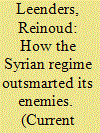

|
|
|
|
|
| Publication |
2013.
|
| Summary/Abstract |
The Assad government watched how uprisings unfolded in Tunisia, Egypt, and Libya, took stock of international reactions to these events, and, in response, developed strategies to maximize its probabilities of survival.
|
|
|
|
|
|
|
|
|
|
|
|
|
|
|
|
| 14 |
ID:
151341


|
|
|
|
|
| Summary/Abstract |
In the last two years, “lone wolf” jihadists seemed to emerge as the new face of terrorism. In December 2015, husband and wife Syed Rizwan Farook and Tashfeen Malik attacked [3] a Christmas party held by Farook’s employer, the San Bernardino County Department of Public Health, killing 14. In June 2016, Omar Mateen killed [4] 49 people at a gay nightclub in Orlando, Florida—the deadliest attack on U.S. soil since 9/11. And in July, Mohamed Lahouaiej Bouhlel drove a truck [5] through a Bastille Day celebration in Nice, killing 86 people.
|
|
|
|
|
|
|
|
|
|
|
|
|
|
|
|
| 15 |
ID:
140470


|
|
|
| 16 |
ID:
158794
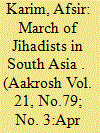

|
|
|
| 17 |
ID:
076658
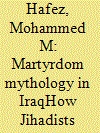

|
|
|
| 18 |
ID:
148929
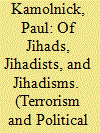

|
|
|
| 19 |
ID:
077344


|
|
|
|
|
| Publication |
2006.
|
| Summary/Abstract |
The thousands of large and small private security establishments operating around the world today continue to expand in number, diversity, and capability. Government oversight is often lacking, and the impact on local, national and regional security and stability may be substantial. In the most troubled areas, the pockets of security provided by private security regimens provide may mean the difference between a failed state and one that is at least faltering. However, the advantages of "private security firm cover" quickly became evident to criminals and groups with terrorist agendas as well. This assessment addresses numerous cases from around the world of private security establishments that were either formed for - or otherwise turned to - the pursuit of criminal or terrorist purposes. The stated jihadist intent to infiltrate such companies underscores the need for law enforcement and intelligence attention to the recruiting, affiliations and activities of these security enterprises
|
|
|
|
|
|
|
|
|
|
|
|
|
|
|
|
| 20 |
ID:
109052
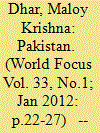

|
|
|
|
|
|
|
|